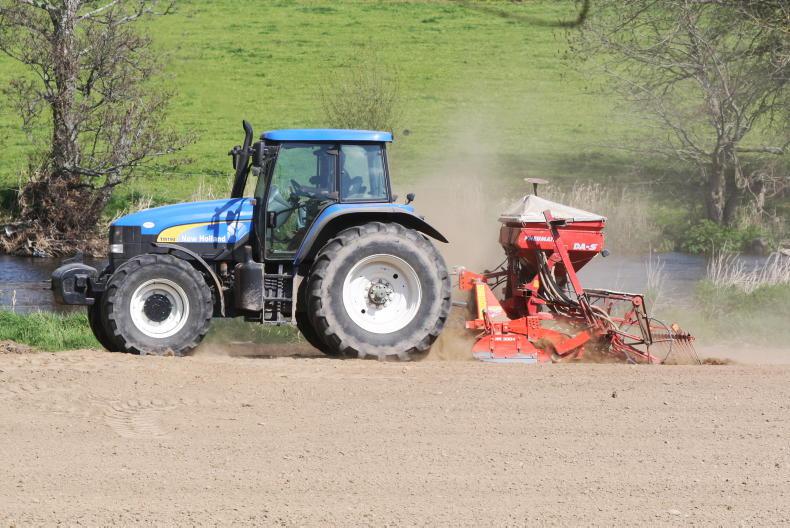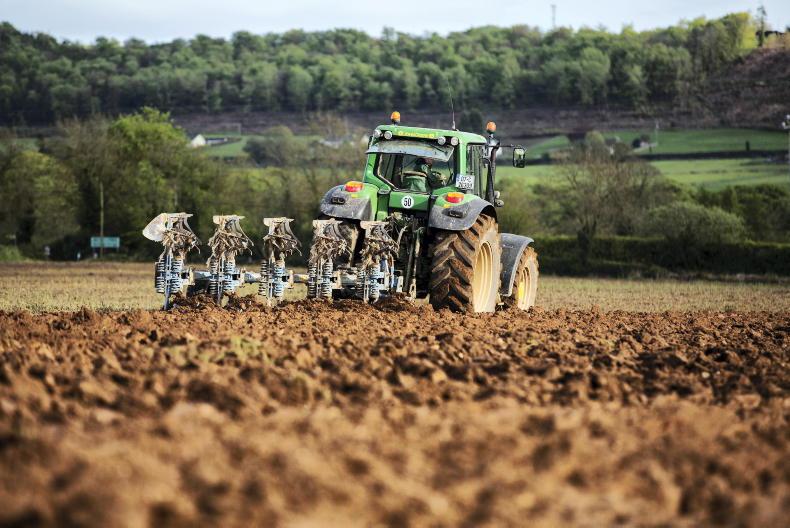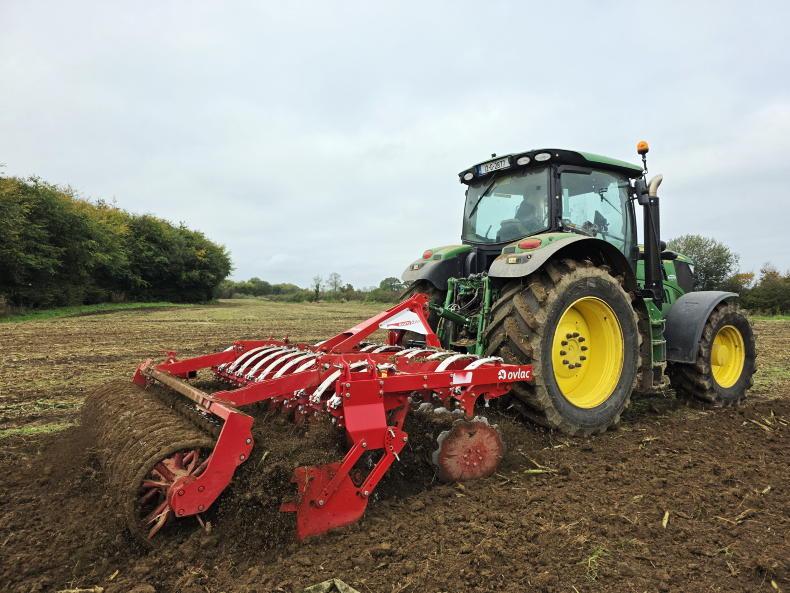The major challenge for organic farmers is to produce enough forage to feed the animals on the farm.
Given that a typical grass sward under mineral soils, with good soil fertility, will only grow about 6t DM/ha of pasture per year with no applied nitrogen, the overall stocking rate on the farm is limited.
Typically, an extra 6t DM/ha could be grown on the same land where say 200kg N/ha was applied in the form of fertiliser, effectively doubling output.
To put it in context, growing 6t DM/ha would barely support one cow and calf for the year, whereas growing 12t DM/ha would support two cows and calves per hectare.
For production-focused organic farmers, the objective should be to try and bridge the gap between what grass will grow with no applied nitrogen and what grass will grow with applied nitrogen. In the case of organic farming, the main source of nitrogen will be clovers, slurry and farmyard manure.

Grass and clover seed is sown after the arable silage seed.
Farmers say it’s much easier to talk about clover than it is to grow it. Establishment challenges are probably greater on organic farms, because some of the tools available to conventional farmers are not permitted, such as glyphosate, post-emergence spray and building up soil fertility with conventional fertilisers. On top of that, there are restrictions on seed use, as at least 70% organic seed should be used – although a derogation to this rule applies if suitable organic seed is not available.
Options
Without using glyphosate, it’s difficult to use minimum tillage or zero tillage techniques for reseeding.
In a conventional scenario these methods work well, as the existing sward is burned off, killing the competition for the new seedlings.
As a result, shallow ploughing is a far more popular method of reseeding on organic farms, as the existing sward is turned off – meaning the new seedlings have less competition.
Ploughing also mineralises more nitrogen from the soil, so there will be more nitrogen available to the seedlings compared to min-till systems.
However, this is a double-edged sword, as nitrogen leaching will also be greater after ploughing and this could be damaging for water quality. Maximum ploughing depth should be six inches.
Weed control
The next issue will be weed control, as post-emergence sprays are not permitted.
The main weed to be worried about is docks, as dock infestations, particularly after ploughing, can be severe. Min-till or zero-till systems are better in this regard – as there is less disturbance of soil, meaning less chance of dormant dock seeds emerging.
For this reason, many organic farmers look to reseed a field as part of a fodder crop rotation. For example, a fodder crop like rape or fodder turnips may be sown in autumn after a cereal crop is harvested and then strip-grazed by cattle over the winter.
Animals grazing the crop will remove all vegetation and churn the soil, creating a clean seedbed for sowing grass/clover seeds in early April.
The advantage of this scenario is that by not having to plough, the amount of weeds in the new reseed should be less.
Another successful option for weed control is to under-sow the grass and clover seeds with a forage crop and cut it for arable silage.

Ploughing is an essential tool in organic farming. \ Donal O'Leary
A common option here is to sow something like barley, peas and oats together, and then come back a couple of days later and sow the grass and clover seeds using a tine harrow or other similar machine. The barley, oats and peas will emerge quickly and provide good cover, therefore shading out weeds like docks. However, the grass and clover seeds will sprout and should take off after the arable silage is harvested in July or early August.
The principle of shading out weeds is often discussed when talking about multi-species swards, even on conventional farms, as no clover-safe options are available that won’t also kill the herbs. The good ground cover and extra competition provided by the various species in a multi-species mixture is said to be good at reducing the weed burden in the field.
Tight grazing is also important not only for pasture quality, but also at suppressing weeds.
This will also promote improved clover content.
Clover has a high requirement for soil pH, preferring soils to be at pH 6.5 and it also requires good soil fertility, with phosphorus and potash at index three.
By having soil pH and soil fertility right, there will be more natural mineralisation of nitrogen plus a greater chance of growing a successful grass and white clover sward.
The major challenge for organic farmers is to produce enough forage to feed the animals on the farm.
Given that a typical grass sward under mineral soils, with good soil fertility, will only grow about 6t DM/ha of pasture per year with no applied nitrogen, the overall stocking rate on the farm is limited.
Typically, an extra 6t DM/ha could be grown on the same land where say 200kg N/ha was applied in the form of fertiliser, effectively doubling output.
To put it in context, growing 6t DM/ha would barely support one cow and calf for the year, whereas growing 12t DM/ha would support two cows and calves per hectare.
For production-focused organic farmers, the objective should be to try and bridge the gap between what grass will grow with no applied nitrogen and what grass will grow with applied nitrogen. In the case of organic farming, the main source of nitrogen will be clovers, slurry and farmyard manure.

Grass and clover seed is sown after the arable silage seed.
Farmers say it’s much easier to talk about clover than it is to grow it. Establishment challenges are probably greater on organic farms, because some of the tools available to conventional farmers are not permitted, such as glyphosate, post-emergence spray and building up soil fertility with conventional fertilisers. On top of that, there are restrictions on seed use, as at least 70% organic seed should be used – although a derogation to this rule applies if suitable organic seed is not available.
Options
Without using glyphosate, it’s difficult to use minimum tillage or zero tillage techniques for reseeding.
In a conventional scenario these methods work well, as the existing sward is burned off, killing the competition for the new seedlings.
As a result, shallow ploughing is a far more popular method of reseeding on organic farms, as the existing sward is turned off – meaning the new seedlings have less competition.
Ploughing also mineralises more nitrogen from the soil, so there will be more nitrogen available to the seedlings compared to min-till systems.
However, this is a double-edged sword, as nitrogen leaching will also be greater after ploughing and this could be damaging for water quality. Maximum ploughing depth should be six inches.
Weed control
The next issue will be weed control, as post-emergence sprays are not permitted.
The main weed to be worried about is docks, as dock infestations, particularly after ploughing, can be severe. Min-till or zero-till systems are better in this regard – as there is less disturbance of soil, meaning less chance of dormant dock seeds emerging.
For this reason, many organic farmers look to reseed a field as part of a fodder crop rotation. For example, a fodder crop like rape or fodder turnips may be sown in autumn after a cereal crop is harvested and then strip-grazed by cattle over the winter.
Animals grazing the crop will remove all vegetation and churn the soil, creating a clean seedbed for sowing grass/clover seeds in early April.
The advantage of this scenario is that by not having to plough, the amount of weeds in the new reseed should be less.
Another successful option for weed control is to under-sow the grass and clover seeds with a forage crop and cut it for arable silage.

Ploughing is an essential tool in organic farming. \ Donal O'Leary
A common option here is to sow something like barley, peas and oats together, and then come back a couple of days later and sow the grass and clover seeds using a tine harrow or other similar machine. The barley, oats and peas will emerge quickly and provide good cover, therefore shading out weeds like docks. However, the grass and clover seeds will sprout and should take off after the arable silage is harvested in July or early August.
The principle of shading out weeds is often discussed when talking about multi-species swards, even on conventional farms, as no clover-safe options are available that won’t also kill the herbs. The good ground cover and extra competition provided by the various species in a multi-species mixture is said to be good at reducing the weed burden in the field.
Tight grazing is also important not only for pasture quality, but also at suppressing weeds.
This will also promote improved clover content.
Clover has a high requirement for soil pH, preferring soils to be at pH 6.5 and it also requires good soil fertility, with phosphorus and potash at index three.
By having soil pH and soil fertility right, there will be more natural mineralisation of nitrogen plus a greater chance of growing a successful grass and white clover sward.











SHARING OPTIONS